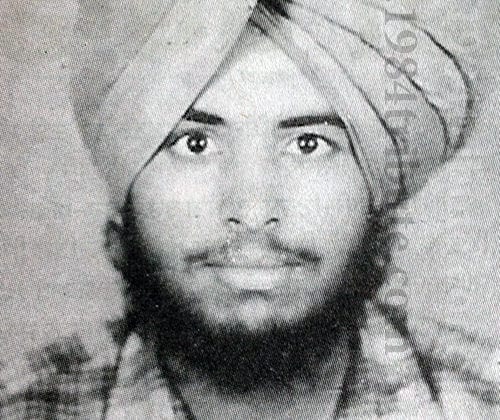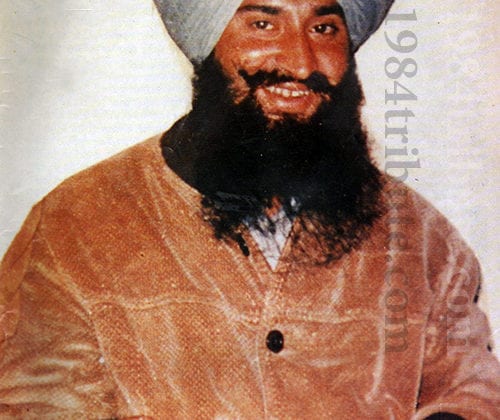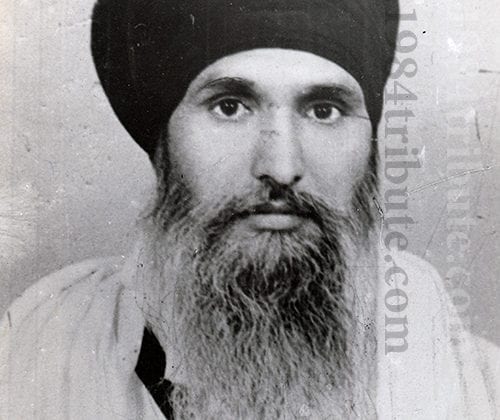Shaheed Bhai Surjit Singh Penta
Shaheed Bhai Surjit Singh Penta
Sikh Student Federation/ Bhindranwale Tigers Force of Khalistan
To the west of Amritsar city, in the heart of Amritsar district and twenty five kilometres on the Jalandhar Road is Chajhalvadi, the ancestral village of Bhai Surjit Singh Penta. Bhai Surjit Singh Penta was born on 10 August 1968 at Mohalla Madangir (Gobindpuri) New Delhi at the house of Sardar Swaran Singh Ji Bal to mother Mahinder Kaur. Bhai Surjit Singh Penta was one of five brothers and sisters. The eldest of them was Amar Shaheed Bhai Paramjeet Singh Ji Kala who obtained martyrdom in the fight for Sikh sovereignty. Second eldest was Bhai Surjit Singh Penta himself. Third was Sister Sarabjit Kaur. Fourth in line was Bhai Harcharan Singh Ji Giani who was imprisoned at Moradabad Jail in Utter Pradesh under T.A.D.A laws. The youngest of the siblings was Amar Shaheed Rajwinder Singh Raja who also obtained martyrdom in the fight for Sikh sovereignty.
Bhai Surjit Singh Penta was educated at the SS Khalsa Senior Secondary School, New Delhi. Alongside his education, he was an excellent athlete winning several awards in the running categories. He would always finish in first place. From his youth, Bhai Sahib was a religious minded and honourable person. He would always look after the females at his college as if they were his own sisters and daughters, and did not allow any mischievous activities to take place at his college. Such was his character, the people of Gobindpuri, New Delhi remember Bhai Surjit Singh Penta with affection to this day.
Bhai Surjit Singh Penta lived at his home in Delhi, from where he secretly conducted service for the Sikh quam. From Punjab had arrived Bhai Harjinder Singh Ji Jinda, Bhai Sukhdev Singh Ji Sukha and Bhai Nirmal Singh Ji Nimma who stayed at his home. From here they based themselves and prepared to punish the enemies of the Sikhs. After conducting investigations in Delhi, they eliminated those directly responsible for the holocaust of Sikhs in Delhi (1984) such as Lalit Makkan and Arjan Dass (both Congress Leaders were reported by eye witnesses to have been leading and equipping the Hindu mobs which massacred thousands of Sikhs in Delhi November, 1984.)
The Delhi Police were alerted to the team very quickly after one of their main enemies, General Aran Kumar Vaidya (led the Indian Army on the attack on Sri Darbar Sahib), was assassinated in Pune, Maharashtra.
The police arrested Bhai Sahib’s Father, Swaran Singh Ji, mother, Mahinder Kaur Ji, maternal grandfather, Sardar Darshan Singh Ji, maternal uncle, Ranjit Singh Ji Rania and charged with Jinda, Sukha, Bhai Harinder Singh alias Bhai Mathra Singh Ji, Bhai Nirmal Singh Ji Nimma and Bhai Sukhwinder Singh Ji Sukhi alias Bhai K.C Sharma. The family was imprisoned at Tihar Jail for four years under the inhuman T.A.D.A laws.
Taking his three brothers and sister, Bhai Surjit Singh Penta arrived in Punjab. He took his elder brother Bhai Paramjeet Singh Kala with him to Sri Darbar Sahib, and after taking prayers they joined the Bhindranwale Tiger Force of Khalistan under the command of Baba Gurbachan Singh Ji Manochahal. Vowing to punish those responsible for the sacrilege of the Sikh faith, people and places of worship, they began their service for the Sikh quam.
Bhai Surjit Singh Penta, working under Bhindranwale Tiger Force of Khalistan acting head Bhai Swarnjit Singh Ji Khalsa Aladinpur, armed himself and then turned his attention towards Delhi to track enemies of the Sikhs there.
Bhai Surjit Singh Penta was devastated by the treatment of Sikhs by those in Delhi, where thousands were slaughtered indiscriminately by Government led mobs, and he was determined to seek revenge. After arming himself from Bhai Swarnjit Singh Ji Khalsa, Bhai Sahib Ji along with Bhai Avtar Singh Patvari, Bhai Surjit Singh Gadli and his own older brother, Bhai Paramjeet Singh Kala they travelled to Delhi. They were given the task of punishing those enemies in Delhi, responsible for the Sikh Genocide in Delhi.
Bhai Surjit Singh Ji’s actions became very famous in Delhi. At an army officer’s house in the Greater Kailash area of Delhi, a party was taking place where several officers were in attendance. Bhai Surjit Singh opened fire on this army officer’s house killing up to fourteen enemies. All the Singh’s successfully escaped from this action. After this, Bhai Sahib along with his group was making their way when an encounter occurred with the Police, but the Singhs quickly despatched four Police officers, causing the remaining officers to flee. From there, Bhai Surjit Singh Penta and his brothers-in-arms left for in Punjab. After paying respects at Sri Harmandir Sahib Ji, they all met with their group. Following the success of their actions, Bhai Sahib Ji’s resolve became even stronger. They were now beyond fear.
At this time in Punjab, thousands of Sikh Youth were being abducted, brutally tortured and killed. The BTFK (along with other Jathebandis) in retaliation targeted those who carried out the atrocities (security forces) and those who planned and sanctioned them (Members of Parliament and other Political Leaders).
After several actions in Delhi and Uttar Pradesh, Bhai Surjit Singh Penta and his elder brother were sat at a dera in village Pakhoke in Punjab when on the information of an informant, Tarn Taran City Inspector Sharma arrived with his entire police force to capture the brothers. The Singhs having seen the Police forces arriving, immediately armed themselves. A fierce gun battle commenced, and although outnumbered the Singhs shot Inspector Sharma dead and escaped with the action adding to their fame in Punjab.
These were dangerous times for Sikhs, especially the fighters. An illegal shoot to kill policy employed by the Security Forces meant certain death for any Fighter caught. Bhai Sahib had many lucky escapes, one day travelling on a bus some of his ammunition fell on his seat which caught the attention of a Thanedar from the Delhi Police and a soldier on the bus. It was one of the last things they saw, as before they could react he immediately shot them dead and the Singhs escaped off the bust. The alarm had been raised, and the small group found themselves being surrounded. As bullets flew through the air, one struck Bhai Avtar Singh Patvari and he attained martyrdom. Bhai Surjit Singh Penta, Bhai Paramjeet Singh Kala and Bhai Surjit Singh Gadli managed to escape towards Punjab. Bhai Surjit Singh Penta had great love for Bhai Avtar Singh Patvari, yet he was not disheartened by his death. He said
‘My beloved brother has been martyred whilst punishing the enemies. I am proud of my brother becoming martyred’.
Such was his commitment to the Sikh Struggle, he was prepared to lay down his life to liberate the Sikh Nation.
Following the Martyrdom of Bhai Swarnjit Singh Ji Khalsa after succumbing to horrific torture at the hands of the Punjab Police, Bhindranwale Tiger Force of Khalistan’s head Baba Gurbachan Singh Ji Manochahal assigned the responsibility of acting head of the group on Bhai Surjit Singh Paint’s shoulders. Obligated to follow this decision, he began by unifying the whole group, and became an even greater threat and headache to the Police. During his tenure as acting head, the group began to swell in numbers of freedom fighters vowing to fight the tyrant government forces until death.
Bhai Sahib Ji would firstly warn his enemies of their wrong doings and only afterwards punish them if they failed to change their ways. Bhai Sahib Ji punished both Pala Bhinder and Chirmal as these two enemies had honoured Julio Francis Rebeiro (Director General of Punjab Police) with a Saropa. Rebeiro has the blood of thousands of Sikh youth on his hands from the time of his tenure in the Punjab Police. Rebeiro employed barbaric methods on the Punjabi people to deafen any uprising or revolt, he later wrote in his memoirs how he used “Black Cats” (police officers disguised as Sikhs) to rape and kill the Punjabi people to try and defame the reputation of the Freedom Fighters.
Following this, Bhai Sahib Ji, took his brother Bhai Paramjeet Singh Kala with him to Tarn Taran where they punished Tarn Taran Jagbani journalist and Sabka Member of Legislative Assembly (M.L.A) Dhavan by shooting him dead. This enemy was considered a traitor to his people who had continuously lied, reporting false information to discredit the Sikh fighters. One day, Bhai Sahib Ji was with his brothers in arms Bhai Bhupinder Singh Kamoke, Bhai Sukhjit Singh Gadli, Bhai Kabal Singh Nibberwind, Bhai Swaran Singh Saidpur, Bhai Vijaypal Singh Lidder and Bhai Harpreet Singh Cheemabad. They were sat on a truck on the way to village Kaleke when during the journey they encountered the S.H.O and D.S.P of Beas Police Station. Gunfire erupted from both parties. D.S.P Harnek Singh managed to hide in the fields and escape. It was no secret
When returning to Calcutta from Bombay, during the journey through district Bhusaval, Maharashtra, Bhai Paramjeet Singh (elder brother of Bhai Surjit Singh Penta) was surrounded by a Police party and in the ensuing encounter, attained martyrdom. On hearing of the martyrdom of his older brother, Bhai Sahib’s resolve did not drop but he thanked Satguru that his older brother was martyred on the battlefield. He would say that if any Singh was martyred, one should not become sad or disheartened, but instead Gurbani should be read as much as possible for those martyred Singhs.
So committed to the struggle for Sikh independence after the loss of his brother, Bhai Sahib Ji enrolled his other younger brothers, Bhai Harcharan Singh Ji Giani and Bhai Rajwinder Singh Raja in to the Khalistani brotherhood. He felt strongly that all must be sacrificed to protect the Punjabi people from being wiped out by the corrupt government forces.
Now Bhai Sahib Ji resumed taking a personal role in actions as well as from Singhs under his command. Bhai Surjit Singh, Bhai Vijaypal Singh Lidder and Bhai Harpreet Singh Cheemabad were sent to Fashionganj in Jalandhar where five Shiv Sena members were murdered. Shiv Sena is a militant right wing political party, which promotes fundamental Hindu Ideology, has expressed admiration for Hitler and implicated numerously for its participation in anti-Muslim and Christian massacres.
Around that time Bhai Surjit Singh Penta was married according to full Gur maryada at village Gagrewal to Bibi Paramjit Kaur. The sacred lavan at Bhai Sahib Ji’s Anand Karaj were read by Baba Gurbachan Singh Ji Manochahal himself. Bhai Sahib Ji arranged the marriage of his younger sister Bibi Sarabjit Kaur to the Chief of the Khalistan Armed Force, Amar Shaheed Bhai Chainchal Singh Udhoke according to full Gur maryada at Sri Darbar Sahib, Amritsar. Bhai Surjit Singh Penta would encourage Sikhs to become courageous heroes like Sant Jarnail Singh Ji Khalsa Bhindranwale.
Bhai Surjit Singh Penta arrived at Sri Darbar Sahib Ji, Amritsar to meet other prominent Sikh Freedom Fighters. The Indian forces became aware, and under the guise of Operation Black Thunder had surrounded Sri Darbar Sahib Ji and were attempting to enter. With the memory of the sacrilege and atrocities committed by the Indian Forces only four years ago still ingrained within the psyche of the Fighters, they were determined to fight until their last breath to protect the sanctity of Sri Darbar Sahib Ji.
Bhai Surjit Singh Penta from 09 May 1988 at one o clock fought with the forces. Many CRP Officers were killed and even the DIG Virk was severely wounded. From 09 May 1988 to18 May 1988 the Government Forces continued firing and attacking Sri Darbar Sahib Ji. Bhai Sahib Ji continued to fight with dedication. On 15 May 1988 at four o clock in the afternoon, with his comrades Bhai Karaj Singh Thande, Bhai Dilbagh Singh Bagga, Bhai Jagir Singh Nangal Lubana, Bhai Amrik Singh Mukatsar, Bhai Dalbir Singh Dhardeo, Bhai Kulwant Singh, Bhai Amrik Singh Chattivind and other Singhs protecting the Gurudwara became martyrs leaving us with the unforgettable memory of their sacrifices and how they lived by the Guru’s words:
‘Mai marnae ka chao hai marao ta har ke duar’
Singh Soorme Mag – Issue 1 June 2010










